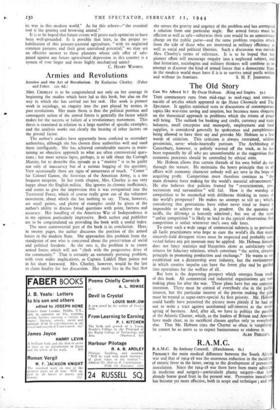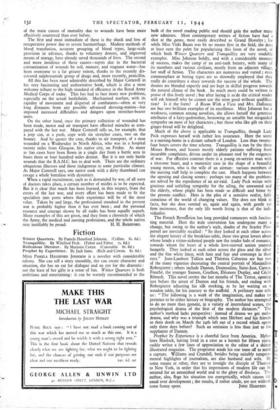R•A•M•C•
R.A.M.C. By Anthony Cotterell. (Hutchinson. (0.) PROBABLY the main medical difference between the South Afri war and that of 1914-18 was the enormous reduction in the inciden of enteric fever in the latter, owing to the development of prevenns inoculation. Since the 1914-18 war there have been many advan in. medicine. and, surgery—particularly plastic surgery—that has already borne good fruit in the present war. Preventive inoculan has become yet more effective, both in scope and technique ; and
of the main causes of mortality due to wounds have been more effectively countered than ever before.
The first and most immediate of these is the shock and loss of recuperative power due to severe haemorrhage. Modern methods of blood transfusion, accurate grouping of blood types, large-scale provision in advance, thanks to voluntary donors, and improved means of storage, have already saved thousands of lives. The second and more insidious of these causes—sepsis due to the bacterial contamination of wounds by soil, manure, and stagnant water—has been overcome to a far greater extent, thanks to the recently dis- covered sulphonamide group of drugs and, more recently, penicillin. All this has been most admirably described by Major Cotterell in his very fascinating and authoritative book, which is also a most welcome tribute to the high standard of efficiency in the Royal Army Medical Corps of today. This has had to face many new problems, especially on the actual battlefields. Mechanised warfare, with its rapidity of movement and dispersal of combatants—often at very long distances from any possible advanced dressing-station—has imposed increased difficulties and dangers upon stretcher-bearer units.
On the other hand, once the primary collection of wounded has been made, motor and air transport have effected miracles as com- pared with the last war. Major Cotterell tells us, for example, that a jeep can, at a push, cope with six stretcher cases, two on the bonnet. And he quotes the case, thanks to air transport, of a man wounded on a Wednesday in North Africa, who was in a hospital twenty miles from Glasgow, his native city, on Friday. As many as 7oo cases have been flown in a single day from a battle area to bases three or four hundred miles distant. But it is not only battle wounds that the R.A.M.C. has to deal with. There are the ordinary ubiquitous illnesses and those indigenous to some particular climate. As Major Cotterell says, one native cook with a dirty thumbnail can ravage a whole battalion with dysentery.
When a rapid recruitment, such as is demanded by war, of all sorts of doctors takes place, a certain number of misfits is to be expected. But it is clear that much has been learned, in this respect, from the errors of the last war, and every effort has been made to fit the specialists into posts where their experience will be of the most value. Taken by and large, the professional standard in the present war is probably higher than it has ever been; and the personal resource and courage shown by all ranks has been equally superb. Many examples of this are given, and they form a chronicle of which the Army, the medical and nursing professions, and the whole nation



























 Previous page
Previous page